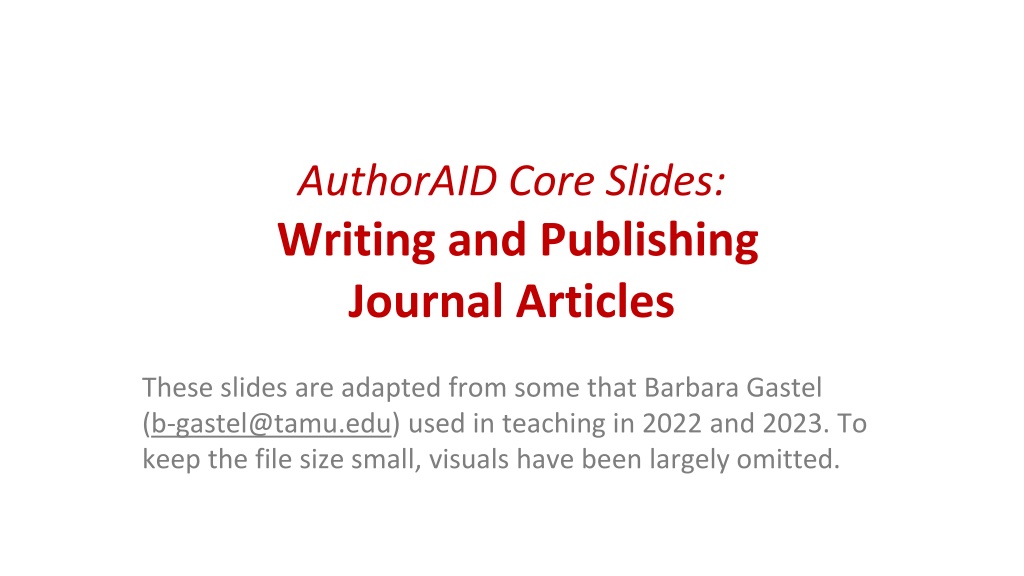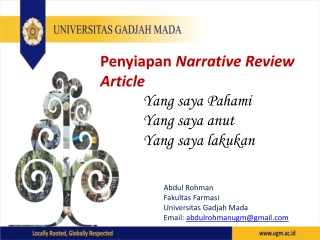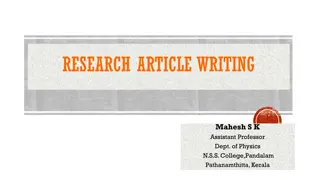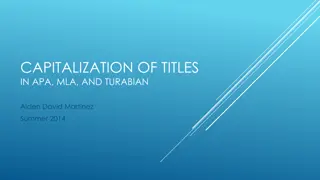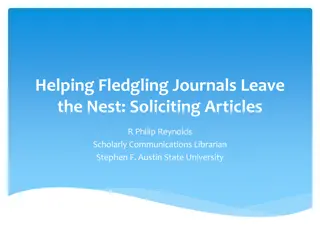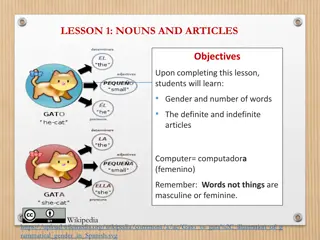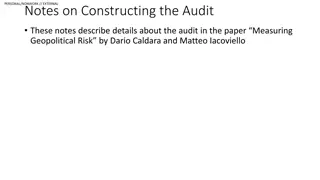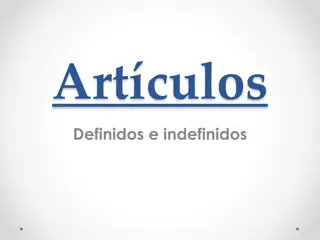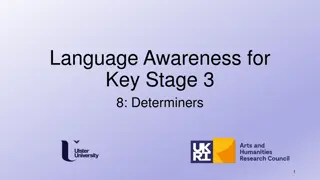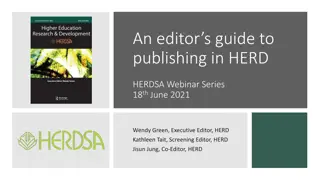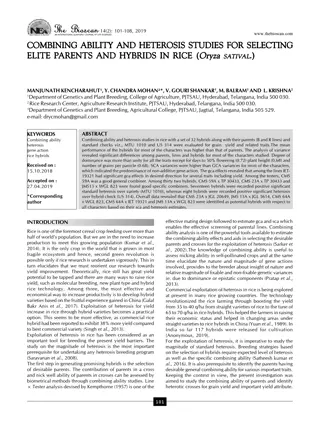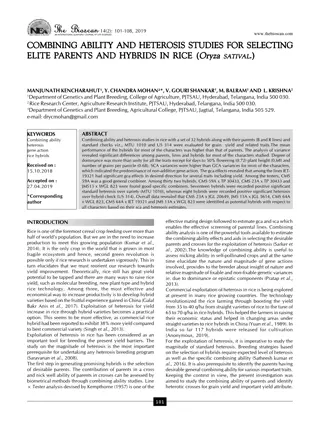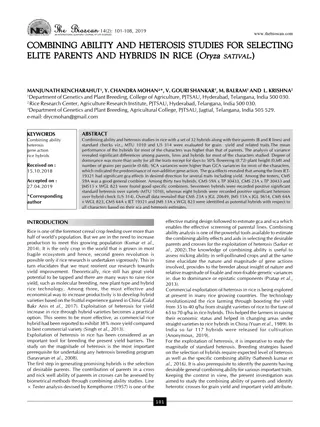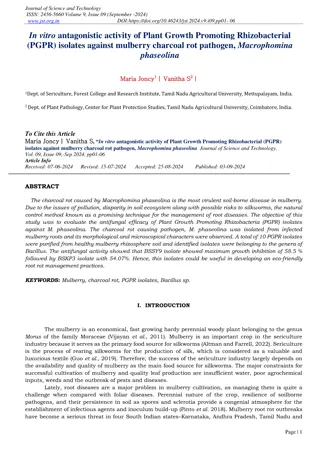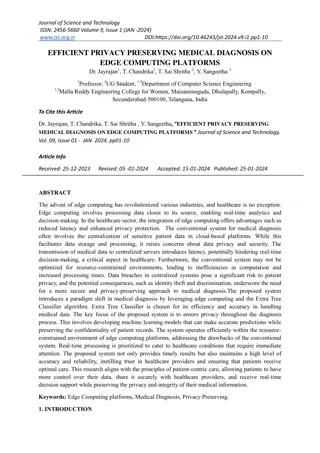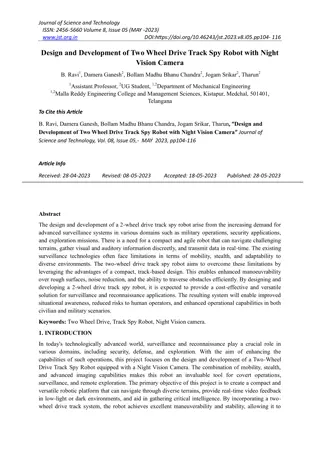Writing and Publishing Journal Articles
These slides cover topics on preparing, structuring, writing, editing, and publishing journal articles. It includes advice on deciding when to publish and identifying target journals.
Download Presentation

Please find below an Image/Link to download the presentation.
The content on the website is provided AS IS for your information and personal use only. It may not be sold, licensed, or shared on other websites without obtaining consent from the author.If you encounter any issues during the download, it is possible that the publisher has removed the file from their server.
You are allowed to download the files provided on this website for personal or commercial use, subject to the condition that they are used lawfully. All files are the property of their respective owners.
The content on the website is provided AS IS for your information and personal use only. It may not be sold, licensed, or shared on other websites without obtaining consent from the author.
E N D
Presentation Transcript
AuthorAID Core Slides: Writing and Publishing Journal Articles These slides are adapted from some that Barbara Gastel (b-gastel@tamu.edu) used in teaching in 2022 and 2023. To keep the file size small, visuals have been largely omitted.
Main Topics Preparing to write a journal article Structure of journal articles Writing a scientific paper: section by section Editing your own work Publishing a paper
Deciding When (or What) to Publish Some factors to consider: quality of the work, extent of the work, interest to others Suggestions: Seek guidance from those in your field who are more experienced in publishing journal articles. Present your work orally first. Doing so can help in (1) deciding whether the work is publishable (2) shaping the paper
Identifying a Target Journal: Some Basics If possible, decide early (before drafting the paper). It s better not to write the paper and then look for a journal. Deciding early can help you target your paper better. Look for journals that have published work similar to yours. Consider journals that have published work you will cite. Consult the journal s website and instructions to authors.
Some Factors to Consider in Choosing a Target Journal Aims and scope of journal Audience Prestige Impact [to be discussed more later] Access (open access; general accessibility) Speed of acceptance and publication; availability of article-based (continuous) publication Quality of reproduction of figures Publication costs, if any Likelihood of acceptance
To Be Avoided: Predatory or Otherwise Questionable Journals Journals that obtain publication fees but are not valid peer-reviewed scholarly publications Some clues that a journal might be predatory (especially if several such items are present): Unrealistically broad scope Unrealistically short stated turnaround times Flashy but poorly crafted, ungrammatical websites Fake metrics Incomplete contact information Other See https://thinkchecksubmit.org/
Impact Impact Factor (from Journal Citation Reports Clarivate Analytics) Indicates how much, on average, articles in the journal are cited Does not say how much a given article will be cited Not valid for comparison from field to field Changes over time Other citation metrics Other impact for example, on practice, policy, teaching, and media coverage
Some Current Issues Whether to post articles in preprint servers before submitting them to journals Long tradition of doing so in physics and related fields Recently, a considerable increase in doing so in biological fields, especially in the wake of COVID-19 Current or proposed requirements by some funding sources that research they fund be openly accessible
Journals Instructions to Authors Usual locations: on the journal s website and in the journal A large collection of links to instructions to authors in the health sciences: http://mulford.utoledo.edu/instr/ General advice: Select your first-choice journal early, and obtain its instructions immediately
Using the Journals Instructions Read the instructions to authors before starting to prepare your paper. Consult the instructions while preparing your paper. Check the instructions again before submitting your paper.
Some Questions the Instructions May Answer What categories of article does the journal publish? What is the maximum length of articles? What is the maximum length of abstracts? What sections should the article include? What are the guidelines for each? Does the journal have a template for articles? If so, how can it be accessed? What guidelines should be followed regarding writing style?
Some Questions (cont.) How many figures and tables are allowed? What are the requirements for them? In what format should references appear? Does the journal post supplementary material online? If so, how should it be provided? In what electronic format should the paper be prepared? How should the paper be submitted?
Beyond the Instructions Be sure to look at some recent issues of the journal (and some recent papers in those issues). Doing so can help you gear your paper to the journal. Note: Recently, some journals have become more flexible about the specific format (reference style etc.) in which papers are initially submitted. However, if a paper is then accepted, the journal may require the authors to revise the formatting to suit its requirements.
Structure of Journal Articles Reporting Research One common structure: IMRAD Introduction: Methods: Results: (And) Discussion: What was the question? How did you try to answer it? What did you find? What does it mean? (Overall structure of content: like an hourglass broad, then narrow, then broad.)
Article Structures (cont.) Structures can differ among academic fields. Non-IMRAD structures in some journals: IRDAM IMRDRDRD . . . Essay format, with headings chosen by author Other
Note People read sections of journal articles in various orders. What order, or orders, do you usually follow? Papers should be written accordingly. Doing so entails ensuring that the article makes sense even if a reader does not begin at the beginning.
Writing a Scientific Paper: Section by Section
Recap: Overall Structure of a Paper Broad (context for the current research) Narrow (focusing on the current research) Broad again (putting the findings in context) Like an hourglass
Overall Structure (Title) (Authors) (Abstract) Introduction Methods Results Discussion (Acknowledgments) (References)
In what order do you like to write the parts of a scientific paper? Why?
One Common Order for Writing a Paper Methods Results Discussion Introduction Final version of abstract Final version of title The slides in this section will be largely in this order.
Authors (and Acknowledgments)
Authors Those with important intellectual contributions to the work A resource: http://www.icmje.org/recommendations/browse/roles- and-responsibilities/defining-the-role-of-authors-and- contributors.html Often listed largely from greatest contributions to least Head of research group often is listed last In some fields, listed alphabetically Useful to list one s name in a consistent way on every paper
ORCID: A Researcher Identification Number Stands for Open Researcher and Contributor ID ORCID provides a persistent digital identifier that distinguishes you from every other researcher ORCID identifiers can aid in tracking authors of papers, grants, etc. Many journals and funders now require use of ORCID IDs See http://orcid.org/
Corresponding Author The author who communicates with the journal and others Should be someone readily reachable during review and publication of the paper Views vary as to whether it is prestigious to have this role
Acknowledgments Often optional A place to thank people who helped with the work but did not make contributions qualifying for authorship Examples: people who provided advice on the research, shared equipment or materials, or gave feedback on a draft of the paper Permission should be obtained from people you wish to list Sometimes the place where sources of financial support are stated
Crediting AI If you use an artificial intelligence (AI) tool, such as ChatGPT, to help write your article, should you list it as an author? No, it doesn t meet the criteria for authorship. However, if you use AI in this way, your paper must say so and explain (in the methods section or elsewhere) how it was used. For more, see Authorship and AI tools | COPE: Committee on Publication Ethics.
Purposes of the Methods Section To allow others to replicate what you did In order to test it In order to do further research To allow others to evaluate what you did To determine whether the conclusions seem valid To determine whether the findings seem applicable to other situations (external validity)
Methods: Basic Information to Include In most cases, overview of study design Identification of (if applicable) Equipment, organisms, reagents, etc., used (and sources thereof; details to provide in that regard may vary) Approval of human or animal research by an appropriate committee Statistical methods Other Procedures
Methods (cont.) In some journals, may include subheads May include tables and figures (examples: flowcharts, maps, diagrams, tables of experimental conditions) Should be written in past tense Often, may include passive voice Helpful to use papers published in the same journal as models
Methods: An Issue How Much Detail to Provide About Well-known methods (can just mention and cite) Methods previously described but not well known (describe briefly and cite) Methods that you yourself devised (describe in detail, or perhaps publish a methods paper and cite it) (a principle here and elsewhere: serve the reader)
Functions of References To give credit to others for their work To add credibility to your work by showing that you used valid information sources To help show how your work is related to previous work To help readers find further information
References: Importance of Accuracy Studies show that many references are inaccurate. For references to fulfill their functions, they must be accurate. Therefore Make sure you accurately state what the cited material says. Make sure all information in the citation (for example, author list, article title, journal title, volume, year, pages) is accurate.
Another Reason Your References Should Be Accurate Often, authors whose work you cite will be your peer reviewers. Inaccurate references to their work will not impress them favorably.
Formats Various formats exist for citation in text for example: Accuracy of references is important (Day and Gastel, 2022). Accuracy of references is important.3 Various formats exist for items in reference lists for example: Pineda D. 2003. Communication of science in Colombia. Sci. Ed. 26:91- 92. Pineda D. Communication of science in Colombia. Sci Ed 2003;26:91-2. Be sure to use the format that your target journal requests.
Citation Management Software Examples: EndNote, RefWorks, Zotero, Mendeley, Papers, Qiqqa Allows you to keep a database of references In many cases, provides the citations and references in the proper format for your target journal A source of information: https://library.tamu.edu/research/citation_management.html
Placement of Citations Ambiguous: This compound has been found in humans, dogs, rabbits, and squirrels (Tuda and Gastel, 1997; Xie and Lozano, 2023; Flores, 2002). This compound has been found in humans, dogs, rabbits, and squirrels.1,4,7 Clear: This compound has been found in humans (Tuda and Gastel, 1997), dogs (Xie and Lozano, 2023), and rabbits and squirrels (Flores, 2002). This compound has been found in humans,1 dogs,4 rabbits,7 and squirrels.7
Other Advice on References If you haven t read an item, don t cite it. If an article isn t freely accessible online, you may well be able to obtain it in another way for example, through a library, through an author s or institution s website, or by contacting the author. Check each reference against the original source. Carefully follow the journal s instructions to authors. Remember that style manuals can be excellent resources in this regard. Consider using references published in the same journal as models. Don t waste lots of time formatting unusual types of references. A copyeditor at the journal can do final formatting.
The Results Section The core of the paper Should present results in a logical order Often includes tables, figures, or both Should summarize findings rather than providing data in great detail Typically, should present results but not comment on them (Some journals, however, combine the Results and the Discussion.)
Verb Tense for the Results Section: Past Tense Examples from Seven-Year Efficacy of RTS,S/AS01 Malaria Vaccine among Young African Children (published in the New England Journal of Medicine): Of the 447 children enrolled in the original trial, 312 completed all three extensions of follow-up . . . Efficacy was consistently lower in the cohort with high exposure to malaria parasites than in the cohort with low exposure (Table 2). All cases of severe malaria resolved without long-term sequelae.
Results Sections of Papers with Tables or Figures How much should the information in the text overlap that in the tables and figures? Not extensive overlap In general, text should present only the main points from the tables and figures Perhaps also include a few of the most important data Remember to mention each table or figure. Do so as soon as readers might want to see it.
Mentioning Tables and Figures: Some Writing Advice In citing tables and figures, generally emphasize the finding, not the table or figure. Usually not so good: Table 3 shows that researchers who took this course published twice as many papers per year. Usually better: Researchers who took this course published twice as many papers per year (Table 3).
Tables and Figures: Some Basics
Tables: A Few Suggestions Use tables only if text will not suffice. Design tables to be understandable without the text. Organize each table in a logical way. If a paper includes a series of tables, use the same format for each. Be sure to follow the instructions to authors.
Figures: A Few Suggestions Use figures (graphs, diagrams, maps, photographs, etc.) only if they will help convey your information. Avoid including too much information in one figure. Make sure that all lettering will be large enough once the figures are published. Follow the journal s instructions.
